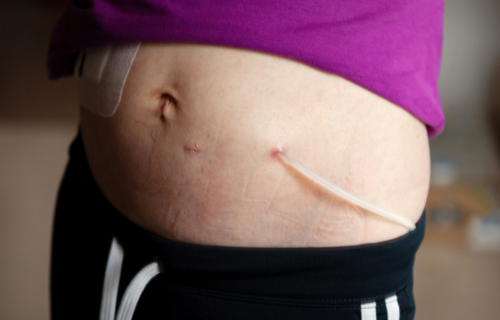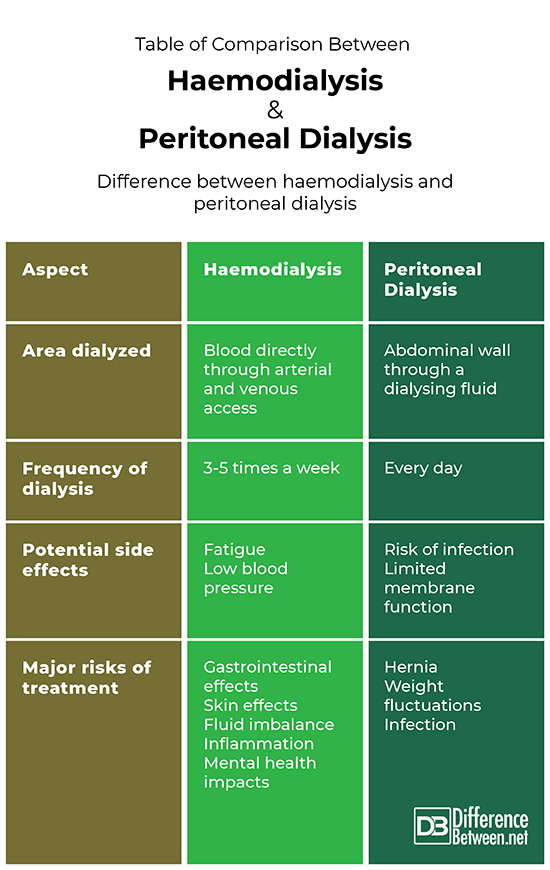Difference Between Haemodialysis and Peritoneal Dialysis

Introduction
Both haemodialysis and peritoneal dialysis involved artificial filtering and balancing of bodily fluids. What makes these treatments different is that one involved the blood and the other involves the abdominal cavity. Although different, both forms of dialysis are necessary and important for specific treatment processes when the kidneys have failed to work.

In this article, we delve a little deeper to find out what the exact differences between the two are!
Indication for Uses
The kidneys are vital organs for the functioning of the human body. They assist in removing wastes from the body through urine. The kidneys also help remove excess salt in the body, excrete extra water, regulate acids and salts, and remove medications that we take in.
When the kidney are heavily diseases or no longer function, these vital balancing processes can no longer take place within the body.
That is where dialysis comes in!
Dialysis is a type of treatment where the blood of a person is cleaned artificially. In other words, the filtration and balancing functions of the kidneys are now replaced by an artificial technology.
Types and Mechanism of Filtration
There are two types of dialysis technologies available. These are haemodialysis and peritoneal dialysis.
Haemodialysis
With haemodialysis, the blood is drawn and cleaned outside of the body. A machine called a dialyzer in connected through a port in an artery and vein in a person’s arm. The machine draws the blood out, cleans and balances its components inside the machine, and cycles it back into the body it came from.
When starting treatment, a temporary catheter is put into the arm for access. At a later stage, surgeons insert a permanent access connection called a fistula.
For this method of dialysis, the patient to be sitting still or lying down throughout the entire procedure 3-5 times a week. After dialysis, patients often feel tired and have low blood pressure.
Haemodialysis is effective but it requires a few dietary restrictions. For example, taking in salt and water is basically a no-go. Another restriction is consuming food that is high in potassium and phosphorus. These restrictions are important to maintain a careful balance of electrolytes and fluids in the body. It is important to follow, as it would simply not be useful to undo all the efforts and work of the treatment!
Peritoneal Dialysis
Peritoneal dialysis is a type of dialysis that occurs inside the body. More specifically, inside the abdomen.
After a catheter is placed into the lining of the abdominal wall (also known as the peritoneum) blood can be filtered internally. Every day, the patient fills the access point with a fluid called dialysate filter. The dialysate filter fluid then cleans and balances the blood components through the internal abdominal walls and once complete, drains into a bag. This collection bag is then emptied by the patient themselves or an appointed caretaker.
The dialysis procedure can be done during the night, therefore not restricting the patient during daytime hours. There is a risk of infection with peritoneal dialysis, especially in the catheter, decreasing the membrane function in the abdominal lining.
Unlike haemodialysis, peritoneal dialysis does not have as many dietary restrictions. This makes it easier to adapt to living with dialysis.
Associated Risks
Haemodialysis tends to carry a few risks to look out for. These may include:
- Low blood pressure with shortness of breath, cramping in muscles and the abdomen, feeling nauseous and vomiting
- Itchy skin that is usually worse just after treatment
- Problems with sleep, restless legs, or sleep apnoea
- High fluid overload or high salt overload
- Inflammation in the heart membrane
- Complications with the access site
- Feelings of depression
Peritoneal dialysis has associated risks and complications too. These potentially include:
- A hernia from abdominal muscle strain after holding the treatment fluid
- Weight gain from the high level of sugar in the treatment fluid
- Infections in the abdominal lining
These risks and complication may occur, but it is not to say that they will necessarily occur when receiving treatment.
Table of comparison between haemodialysis and peritoneal dialysis

Summary
Haemodialysis and peritoneal dialysis are both life-saving treatments for patients suffering with severe impaired kidney functions. Haemodialysis works directly with the blood and dialyses outside of the body, where peritoneal dialysis works with the blood via the abdominal cavity and dialyses inside the body.
Both treatment options come with associated risks and complications. Both treatment options also have their own benefits. For example, haemodialysis is more effective in severely impaired kidney function but peritoneal dialysis can be done overnight in the comfort of the patient’s bed.
The suitability and choice of treatment will depend on various factors including the severity of the condition, lifestyle factors, treatment environments and the personal choice of a qualified specialist.
FAQ
When is haemodialysis used?
Haemodialysis is used when the body’s kidneys no longer function. It is preferred if the patient is unable to perform dialysis by themselves at home, as well as in very serious cases. It may be the chosen type of dialysis if the specialist physician prefers it, if a patient is obese, in patients with abdominal scarring and based on the quality of life of the patient receiving it.
Which is safer, haemodialysis or peritoneal dialysis?
The safety of haemodialysis and peritoneal dialysis is influenced by the factors surrounding a patient. These factors include the level of kidney function, overall health, lifestyle and home environment, the preference and experience of the specialist physician, and the ability to take the steps for treatment. In other words, certain treatment options are more suitable for specific patients and are therefore the safer treatment option to go for!
- Difference Between a Cochlear Implant and Normal Hearing - October 4, 2022
- Difference Between Obstructive and Restrictive Spirometry - September 11, 2022
- The Difference Between White Box and Black Box Testing - September 11, 2022
Search DifferenceBetween.net :
Leave a Response
References :
[0]Durham Nephrology Associates. Hemodialysis Vs. Peritoneal Dialysis: Which is right for you. https://www.durhamnephrology.com/hemodialysis-vs-peritoneal-dialysis/#:~:text=Peritoneal%20dialysis%20offers%20continuous%20filtration,people%20who%20have%20abdominal%20scarring.
[1]National Kidney Foundation. Peritoneal Dialysis: What You Need to Know. https://www.kidney.org/atoz/content/peritoneal#:~:text=In%20hemodialysis%2C%20blood%20is%20pumped,acts%20as%20a%20natural%20filter
[2]Sinnakirouchenan, Ramapriya and Holley, Jean. L. “Peritoneal Dialysis versus Hemodialysis: Risks, Benefits, and Access Issues”. Advances in Chronic Kidney Disease, vol. 18, no. 6, 2011, pp. 428-432
